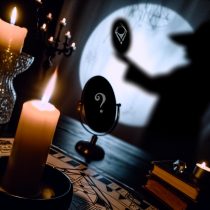Understanding Scrying
Scrying, an ancient art steeped in history and mystery, has been practiced across cultures for centuries. It is the process of receiving insights through visions or images perceived in a reflective medium. Traditionally linked with divination and esoteric practices, scrying is not merely about seeing images; it’s about interpreting the messages those images might convey. The typical mediums used in scrying include crystals, mirrors, water, and other reflective surfaces. For practitioners, understanding these images requires a delicate balance of intuition and symbolic literacy.
The Role of Reflection
Reflective surfaces in scrying serve more than a mere physical function. They are believed to act as gateways to the subconscious and spiritual realms, projecting symbolic images that hold deeper meanings. Rather than focusing on the literal representations of these images, practitioners see them as metaphors. This reflective quality encourages individuals to adopt a meditative approach, allowing their minds to engage more profoundly with introspective processes. Through this, scrying becomes an exercise in quiet reflection and deeper understanding.
Symbolic Interpretation
The interpretation of images seen during scrying is steeped in the understanding of symbols and their potential meanings. Context plays a pivotal role in this process because while some symbols may appear universal, their interpretations can greatly vary depending on personal experiences and cultural backgrounds. For example, water might generally symbolize emotions due to its fluid nature, but in a specific context, it could represent something entirely different, such as transition or cleansing. Thus, keeping an open mind and considering individual symbolic language alongside archetypal imagery is crucial.
Common Symbols in Scrying
Certain symbols appear frequently during scrying sessions and have gathered widely accepted interpretations over time:
Water: Often symbolizes emotions and intuition, reflecting the depths of the subconscious mind. However, it can also signify change or renewal, much like the cycle of water in nature.
Trees: Typically represent growth, life, and stability, symbolizing how deeply rooted personal beliefs or experiences may be, yet pointing to the potential for growth and change.
Birds: Commonly associated with freedom, spirituality, or journeys. They can imply aspirations or the pursuit of higher knowledge and understanding.
Light: Symbolizes illumination, clarity, or epiphanies, often marking moments of insight or enlightenment in the scryer’s life journey.
While these interpretations provide a foundational understanding, it’s crucial for practitioners to explore what these symbols might mean within their personal contexts.
Developing Intuition
Cultivating an intuitive understanding is essential to successfully interpret the images perceived during scrying. This involves learning to trust one’s gut feelings and personal insights, which can be honed over time. Practices like meditation and journal keeping are effective tools to enhance this intuition. Through meditation, scryers can quiet their minds and attune themselves to subtle insights, while a journal allows for the documentation of experiences, facilitating reflection and recognition of personal symbols.
Enhancing Interpretive Skills
Keeping a dedicated scrying journal can significantly aid in enhancing interpretive skills. Scryers should document the images they see, their emotional responses to these images, and any reflections or insights gained over time. Over time, patterns and recurring symbols or themes may emerge, providing a deeper understanding that is uniquely personal. This practice can be instrumental in differentiating between personal insights and established symbolic meanings, thereby refining one’s intuitive abilities.
Approaches to Interpretation
Different traditions of scrying advocate various approaches to interpretation, each offering unique benefits:
Meditative Approach: Emphasizes focusing on the natural flow of thoughts and emotions. In this method, scryers avoid forcing interpretations and instead allow meanings to surface organically, leading to a more intuitive understanding.
Analytical Approach: Encourages a systematic examination of each image against known symbolic meanings. This method draws upon established symbolism to create a structured framework for interpretation.
Contemplative Approach: Balances intuition with logic, combining personal insights with recognized interpretations. This approach offers a holistic view, merging the subjective and objective aspects of scrying.
The Role of Intuition
Intuition is central to the practice of scrying, as it allows for a personal and profound connection to the meanings behind the symbols. As individuals continue to practice and refine their scrying abilities, their intuitive understanding deepens, aiding in forming interpretations that resonate on a personal level. By nurturing this intuitive side, practitioners can achieve a more comprehensive view that bridges the gap between external symbols and internal states.
Final Reflections
Ultimately, the practice of scrying and its interpretations heavily rely on personal growth and the willingness to delve into both external symbolism and internal introspection. While universal meanings and commonly accepted symbols provide a foundation, it is the unique, personal insights that enrich the process and lead to meaningful interpretations. For those intrigued by the art of scrying and eager to explore its depths, further resources offer additional insights into its significance and study. This ongoing journey of discovery promises to open new vistas of understanding, blending ancient traditions with contemporary practices, and offering a uniquely personal experience to each practitioner.










